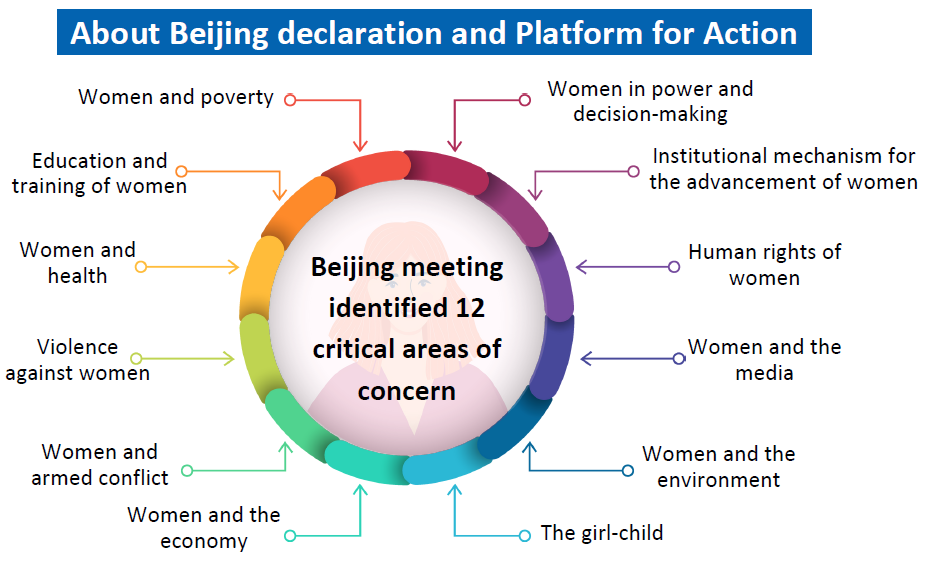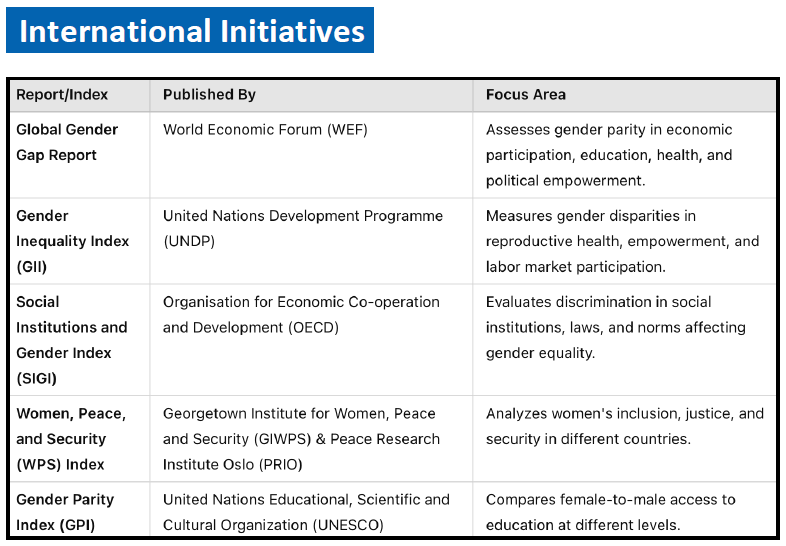Syllabus: GS2/Issues Related To Women
Context
- Nearly three decades after the adoption of Beijing Declaration and Platform for Action (1995), the struggle for women’s rights in India remains complex and multifaceted.
About the Beijing Declaration and Platform for Action (1995)
- It was adopted at the Fourth World Conference on Women (United Nations) in 1995, to provide a comprehensive framework for gender equality.
- It identified 12 critical areas of concern, including poverty, education, health, violence against women, and women’s participation in power and decision-making.

- It emphasized women’s rights as human rights, advocating for reforms in education, political participation, economic empowerment, health, and protection from violence.
- Other International Treaties Where India is a Signatory:
- Universal Declaration of Human Rights (1948);
- International Covenant on Civil and Political Rights (ICCPR, 1966);
- Convention on the Elimination of All Forms of Discrimination Against Women (CEDAW, 1979);
- United Nations Convention Against Corruption (2003);
- Agenda 2030 for Sustainable Development;
- India is a signatory to all above treaties, including the Beijing Declaration and Platform for Action.
| International Women Day – Celebrated on 8 March – Originated from the Labour Movement in the early 20th century to advocate for women’s rights. – Theme (2025): For ALL Women and Girls: Rights. Equality. Empowerment – Objective: 1. To celebrate the achievements and contributions of women and raise awareness about gender equality and persisting challenges faced by women. National Women Day – Celebrated on 13 February – To commemorate the birth anniversary of Sarojini Naidu, a renowned political leader, poet, and champion of women’s rights. Objective: 1. To recognize the diverse struggles and dreams of women, promoting gender equality and leadership |
Constitutional and Legal Framework
- Fundamental Rights:
- Article 14: It ensures equality before the law;
- Article 15: It prohibits discrimination based on sex.
- Directive Principles of State Policy
- Article 51(a)(e): It encourages citizens to renounce practices derogatory to women’s dignity.
- Articles 39 and 42: These emphasize equal livelihood opportunities, equal pay, and maternity relief.
India’s Progress Since Beijing Declaration
- Improved Maternal Health:
- Under-5 Mortality Rate (U5MR) decreased from 43 (2015) to 32 (2020).
- Life expectancy for women increased to 71.4 years (2016-20), expected to reach 74.7 years by 2031-36.

- Nutrition and Sanitation:
- Jal Jeevan Mission provided potable tap water to 15.4 crore households, reducing health risks.
- Swachh Bharat Mission: Construction of 11.8 crore toilets, improving sanitation and hygiene.
- Poshan Abhiyaan: Strengthens maternal and child nutrition programs
- Ujjwala Yojana: Over 10.3 crore clean cooking gas connections distributed.
- Education: The ‘Beti Bachao Beti Padhao’ initiative has improved the child sex ratio and increased school enrollments for girls.
- The National Education Policy 2020 has further paved the way for higher retention rates and opportunities in STEM fields.
- Female Gross Enrollment Ratio (GER) has overtaken Male GER since 2017-18.
- Female enrolment in higher education: 2.07 crore (2021-22), which is nearly 50% of the total number 4.33 crore.
- The female to 100 male faculty ratio has also improved to 77 in 2021-22 from 63 in 2014-15.
- Women in STEM: 42.57% (41.9 lakh) of total STEM enrolment.

Economic Empowerment and Financial Inclusion
- Women’s participation in major household decisions: Increased from 84% (2015) to 88.7% (2020).
- Financial Inclusion:
- PM Jan Dhan Yojana: Over 30.46 crore accounts (55% belonging to women) opened.
- Stand-Up India Scheme: 84% of loans under ₹10 lakh to ₹1 crore sanctioned to women entrepreneurs.
- MUDRA Scheme: 69% of microloans given to women-led enterprises.
- Self-Help Groups under NRLM: 10 crore (100 million) women connected to 9 million SHGs.
- Bank Sakhis Model: 6,094 women banking correspondents processed transactions worth $40 million in 2020.
- Employment and Leadership:
- Women in Armed Forces: Entry into NDA, combat roles, and Sainik Schools.
- Civil Aviation: India has over 15% women pilots, higher than the global average of 5%.
- Working Women’s Hostels (Sakhi Niwas): 523 hostels benefiting 26,306 women.
- Women Entrepreneurs in Startups: 10% of funds in the Small Industries Development Bank of India reserved for women-led startups.
- Gender Responsive Budgeting: The share of the Gender Budget in the total national Budget has increased from 6.8% in 2024-25 to 8.8% in 2025-26; $55.2 billion is allocated toward gender-specific programmes.
Digital and Technological Empowerment
- Digital India Initiatives:
- PMGDISHA (Prime Minister’s Digital Saksharta Abhiyan): 60 million rural citizens trained in digital literacy.
- Common Service Centres (CSCs): 67,000 women entrepreneurs running digital service centers.
- Ayushman Bharat Digital Mission (ABDM): Bridging healthcare accessibility through digital solutions.
- SANKALP Hubs for Women Empowerment: Functioning in 742 districts across 35 States/UTs.
Political Representation
- The 73rd and 74th Constitutional Amendments mandated 33% reservation for women in Panchayati Raj Institutions (local self-governance bodies), significantly increasing their participation at the grassroots level.
- The recent Women’s Reservation Bill (2023) aims to reserve 33% of seats for women in the Lok Sabha and state legislatures.
| Safety and Protection Measures | |
| Key Legal Frameworks | Institutional and Legislative Reforms |
| – Criminal Law (Amendment) Act, 2018 – Protection of Women from Domestic Violence Act, 2005 – Sexual Harassment of Women at Workplace Act, 2013 – POCSO Act, 2012 – Ban on Triple Talaq (2019) – Dowry Prohibition Act, 1961 – Prohibition of Child Marriage Act, 2006 | – Bharatiya Nyaya Sanhita (BNS), 2023: 1. Strengthens provisions for gender justice. 2. Enhanced punishment for sexual offenses and trafficking. 3. Witness protection and digital evidence admissibility improved. – Women’s representation in CAPFs: 33% reservation in select forces. – Nari Adalat: Piloted in 50 Gram Panchayats each in Assam and J&K, now expanding. |

Challenges Hindering a Feminist Future in India
- Workforce Participation and Economic Barriers: India has one of the lowest female labor force participation rates (FLFP) globally, at around 24% (World Bank, 2022). Women face multiple barriers, including:
- Unpaid care work burden
- Lack of workplace safety and maternity benefits
- Gender pay gap and informal sector exploitation
- Deep-Rooted Patriarchy and Cultural Barriers: Despite progressive laws, patriarchy remains embedded in Indian society.
- Gender roles, honor-based restrictions, and moral policing continue to limit women’s autonomy in both rural and urban spaces.
- Urban-Rural Divide in Feminist Narratives: Feminism in India often remains urban-centric, sidelining the struggles of Dalit, Adivasi, and rural women whose issues differ significantly from those of privileged women.
- Land rights, access to education, and economic independence are still distant dreams for many.
- Economic Inequality and Unpaid Labor: Women contribute significantly to India’s informal economy, yet gender pay gaps and unpaid care work remain largely unaddressed.
- The burden of domestic labor continues to reinforce economic dependence.
- Rise of Digital Misogyny: With the increasing penetration of digital platforms, online harassment and gendered cyber violence have emerged as new-age challenges that restrict women’s participation in digital spaces.
- Political Representation: While women’s political participation has increased, representation is often symbolic rather than substantive.
- Women in governance are still outnumbered and face structural barriers in decision-making roles.
Way Forward: Unlocking a Feminist Future
- Centering Intersectional Feminism: India’s feminist future must be inclusive of caste, class, religion, and disability-based discrimination.
- Policies must be designed not just for elite women but for the most marginalized groups.
- Strengthening Grassroots Movements: Empowering rural and tribal women’s collectives, such as the Self-Employed Women’s Association (SEWA), can ensure that gender justice is community-driven rather than top-down.
- Recognizing and Redistributing Unpaid Labor: Legislative frameworks should account for unpaid domestic labor by recognizing women’s economic contributions through policies such as universal basic income or care economy investments.
- Combating Digital Gender-Based Violence: Stronger cyber laws, digital literacy programs, and accountability for online platforms are needed to make digital spaces safer for women.
- Beyond Quotas: Meaningful Political Participation: Women’s reservation in Parliament must go beyond numbers, ensuring women in leadership roles actively shape policy agendas.
- Initiatives for mentorship and capacity building can enhance their political agency.
| Daily Mains Practice Question [Q] Critically analyze India’s progress in advancing gender equality since the Beijing Declaration. What challenges persist in achieving a feminist future, and what innovative measures and societal changes are required to address these gaps effectively? |
Previous article
Over-Centralisation Threatens Federal Health Policy
Next article
Leadership Crisis In Middle East